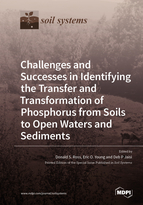Challenges and Successes in Identifying the Transfer and Transformation of Phosphorus from Soils to Open Waters and Sediments
A special issue of Soil Systems (ISSN 2571-8789).
Deadline for manuscript submissions: closed (1 January 2021) | Viewed by 38115
Special Issue Editors
Interests: soil chemistry; phosphorus; hydropedology
Interests: phosphorus biogeochemistry; soil nutrient management; water quality
Special Issues, Collections and Topics in MDPI journals
Special Issue Information
Dear Colleagues,
Anthropogenic loading of phosphorus to water bodies continues to increase worldwide, in many cases leading to increased eutrophication and harmful algal blooms. Determining the sources of phosphorus and biogeochemical processes responsible for this increase is often difficult because of complexity on inputs and pathways, which vary both in spatial and temporal scales. In order to effectively develop strategies to improve water quality, it is essential to develop a comprehensive understanding of the relationship of P pools with biological uptake and cycling under varied soil and water conditions. A wide variety of processes, including changes in phosphorus speciation, transformations between organic and inorganic species, and transfer between biotic and abiotic forms, occur along the route from soils to open waters and to sediments until ultimate burial, and together increase the complexity of quantifying processes, cycling, or tracing sources. In addition, climate-change-related effects and feedback thereof often exacerbate a number of processes, including redox-mediated release of legacy phosphorus in sediments.
We invite papers that address the topic of soil P processes involving transfer and transformation across the landscape, either presenting novel research methods or synergy among non-traditional research fields, a review of existing successes and failures with underlying causes, or data-driven recommendations on the various approaches necessary to mitigate P loss and achieve the tangible goal of improving water quality.
Dr. Donald S. Ross
Dr. Eric O. Young
Dr. Deb P Jaisi
Guest Editors
Manuscript Submission Information
Manuscripts should be submitted online at www.mdpi.com by registering and logging in to this website. Once you are registered, click here to go to the submission form. Manuscripts can be submitted until the deadline. All submissions that pass pre-check are peer-reviewed. Accepted papers will be published continuously in the journal (as soon as accepted) and will be listed together on the special issue website. Research articles, review articles as well as short communications are invited. For planned papers, a title and short abstract (about 100 words) can be sent to the Editorial Office for announcement on this website.
Submitted manuscripts should not have been published previously, nor be under consideration for publication elsewhere (except conference proceedings papers). All manuscripts are thoroughly refereed through a single-blind peer-review process. A guide for authors and other relevant information for submission of manuscripts is available on the Instructions for Authors page. Soil Systems is an international peer-reviewed open access quarterly journal published by MDPI.
Please visit the Instructions for Authors page before submitting a manuscript. The Article Processing Charge (APC) for publication in this open access journal is 1800 CHF (Swiss Francs). Submitted papers should be well formatted and use good English. Authors may use MDPI's English editing service prior to publication or during author revisions.
Keywords
- phosphorus speciation
- eutrophication
- phosphorus mobility
- bioavailable and recalcitrant phosphorus
- phosphorus pools
- legacy P and quantitation






